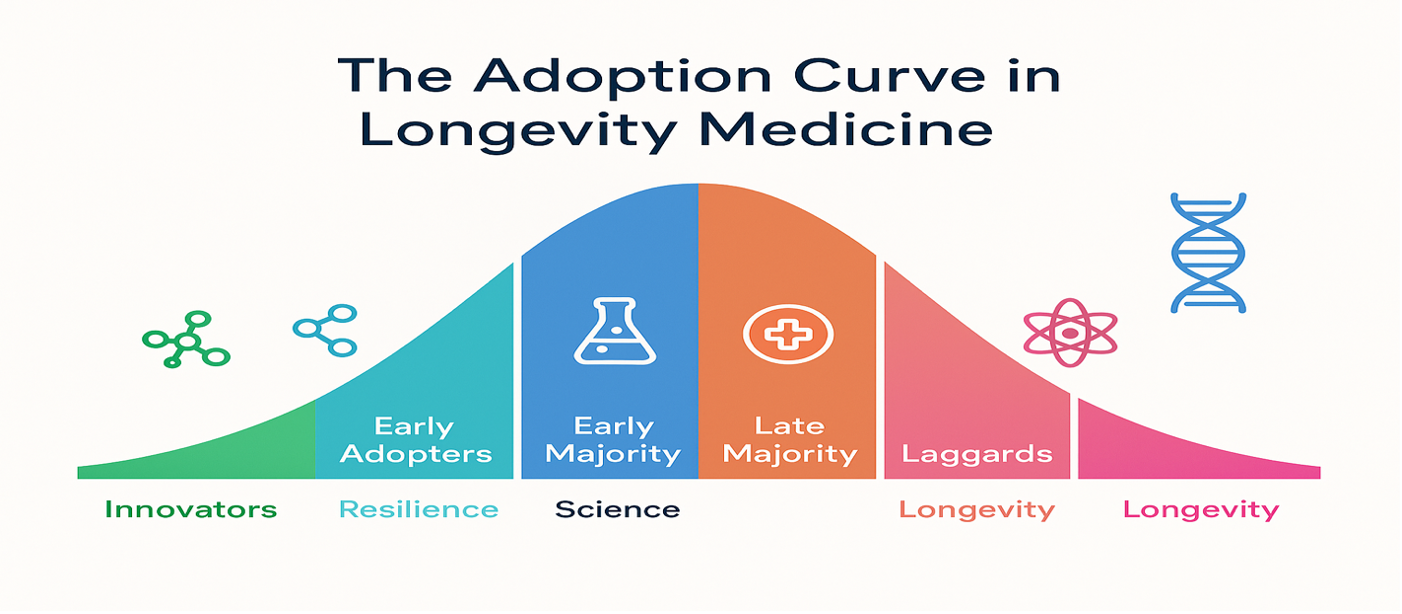Where Are We on the Curve? –
In The Tipping Point, Malcolm Gladwell explores how small, well-timed shifts can trigger significant change. One day, an idea seems fringe, something reserved for biohackers or forward-thinking doctors, and the next, it’s on everyone’s radar.
This captures where longevity medicine stands today, perfectly.
Once seen as an experimental corner of healthcare, longevity-focused approaches are edging closer to the mainstream. But we’re not there yet. To better understand how close we might be, we can turn to Rogers’ Innovation Adoption Curve, a framework that explains how new ideas spread from the earliest pioneers to the broader public.

Let’s explore where longevity medicine fits in.
1. Innovators – The Pioneers (2.5%)
These are the self-experimenters, the bold thinkers, the curious clinicians who ask the deeper “why” behind symptoms. They don’t just treat conditions, they try to decode them.
At Alchemi, we’ve encountered these pioneers: doctors who map out inflammation like a blueprint, trace metabolic dysfunction back to root causes, and explore how the body’s systems interconnect. They treat medicine as both an art and a science, looking for upstream answers rather than downstream fixes.
They’re not reckless. They’re researchers, reverse-engineers, and often, the ones asking the questions that reshape the field.
2. Early Adopters – The Optimisers (13.5%)
This group is growing fast. These are health professionals and high-performing individuals who take their well-being seriously. They’re not waiting for decades of consensus if the evidence and outcomes are compelling now.
We’re seeing:
• Functional and integrative practitioners using compounded hormones, high-dose nutrient IVs, and lifestyle medicine in comprehensive care plans.
• Patients who treat health like a long-term investment, not a reactive chore.
• Clinics offering holistic protocols focused on biological age, energy, cognition, mood, and metabolic resilience.
In South Africa and globally, we’re still in the early adopter phase. The interest is building. Clinicians are paying attention. But few have fully reoriented their practices around longevity. Yet.
3. Early Majority – The Realists
This is the group that will push longevity medicine from niche to normal.
They want data. They want to see results. Often, they’re inspired by friends, family, or their own tracked improvements.
They’re:
• Patients joining structured longevity or health optimisation programs.
• People monitoring sleep, glucose, HRV, and recovery with wearables.
• Clinicians, starting to incorporate tools like biological age testing, hormone balancing, and targeted nutritional protocols into their care models.
The early majority isn’t drawn by hype; they’re driven by outcomes. And once they get on board, the field moves beyond its tipping point.
4. Late Majority – The Wait-and-Seers (34%)
For this group, adoption happens only once longevity becomes conventional care. Think:
• Coverage by medical aid and insurance
• Endorsements from national healthcare boards
• Availability in standard clinics and hospital networks
And that’s perfectly okay. Every innovation follows its own timeline. Once the early majority shifts, the late majority follows.
5. Laggards – The Sceptics (16%)
There will always be some who remain cautious or unconvinced. They prefer conventional systems. They’ve seen trends come and go and aren’t swayed by emerging research or anecdotal results.
That, too, is part of the curve. Not every modality is for everyone. And not everyone needs to be an early mover.
So Where Are We Now?
Right now, science is advancing. Patient demand is growing. And more healthcare providers are shifting from “What’s the pill for the symptom?” to “What’s driving this imbalance in the first place?”
At Alchemi, we see this shift daily, people seeking not just to live longer, but to live better. Health span over lifespan. Function over fixation.
Clinicians are beginning to think systemically:
How do we optimise health? How do we prevent decline before it begins?
We’re still early on the curve, but the curve is steepening.
It’s no longer a question of whether longevity medicine will go mainstream.It’s only a question of when.
The Takeaway
Longevity medicine is moving closer to the tipping point, led by pioneers, supported by optimisers, and watched closely by the realists.
Whether you’re already exploring bioidentical hormone therapy, IV nutrient support, or full-spectrum wellness protocols—or simply curious about where it’s all heading—you’re part of a movement that’s redefining health for the better.
The future of medicine isn’t just about adding years. It’s about adding life to years.


